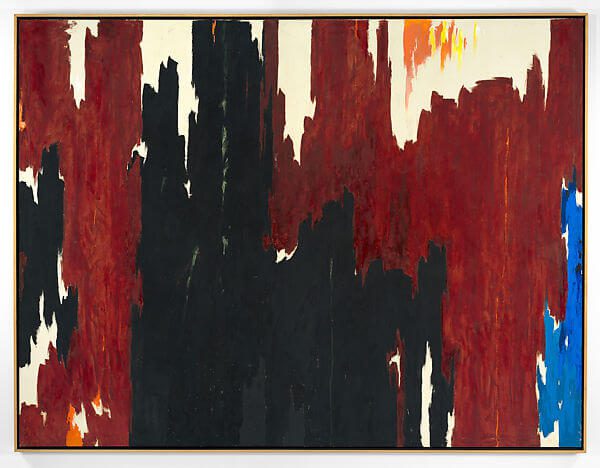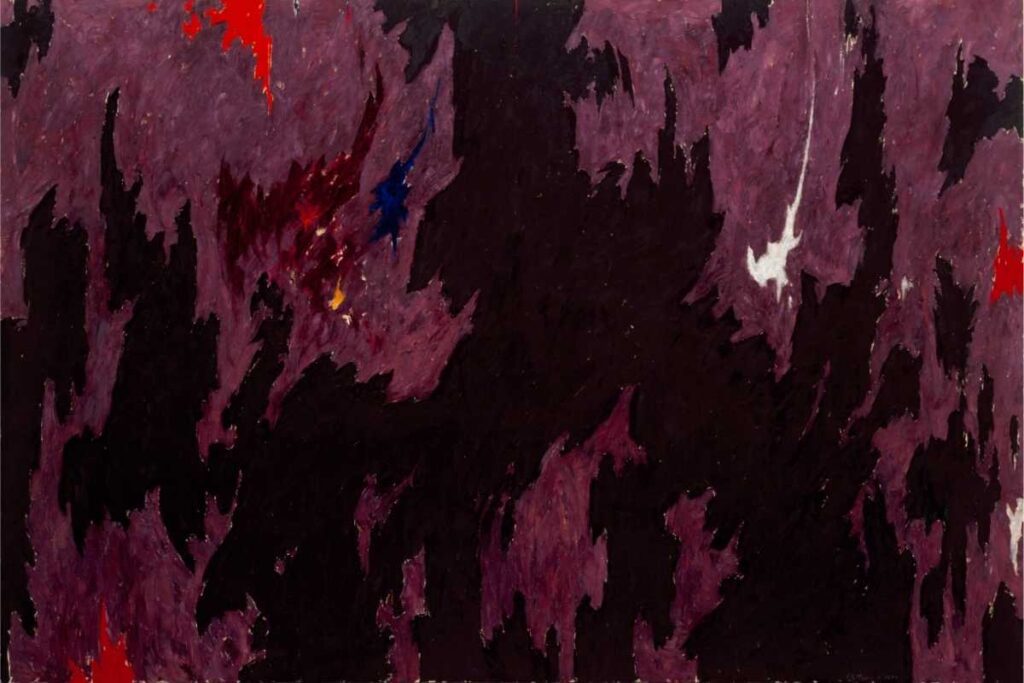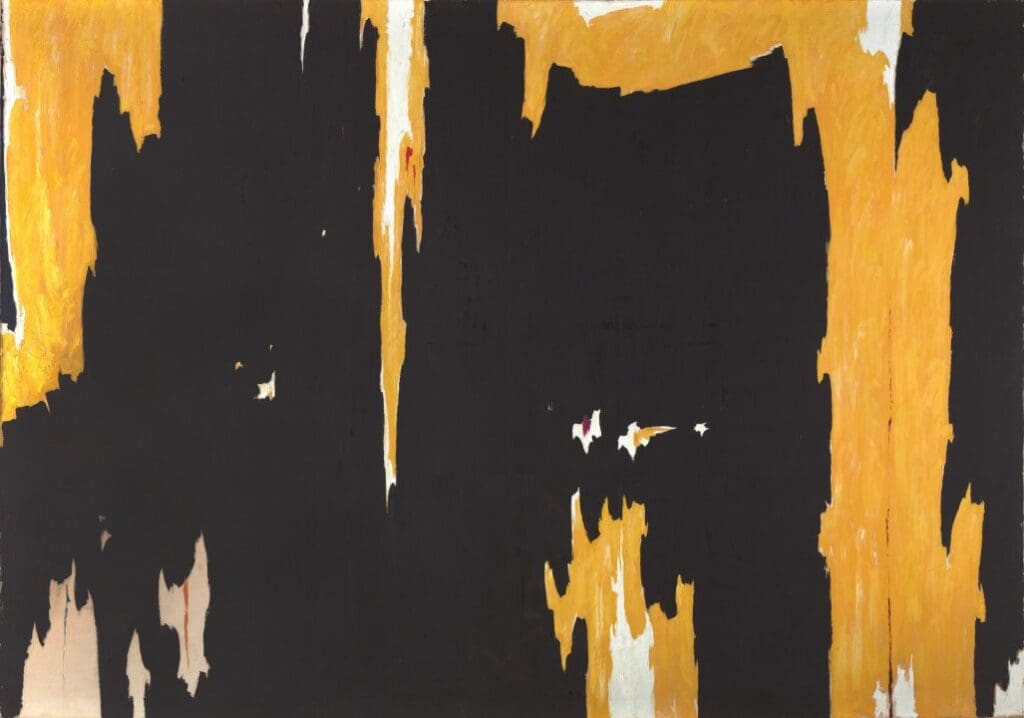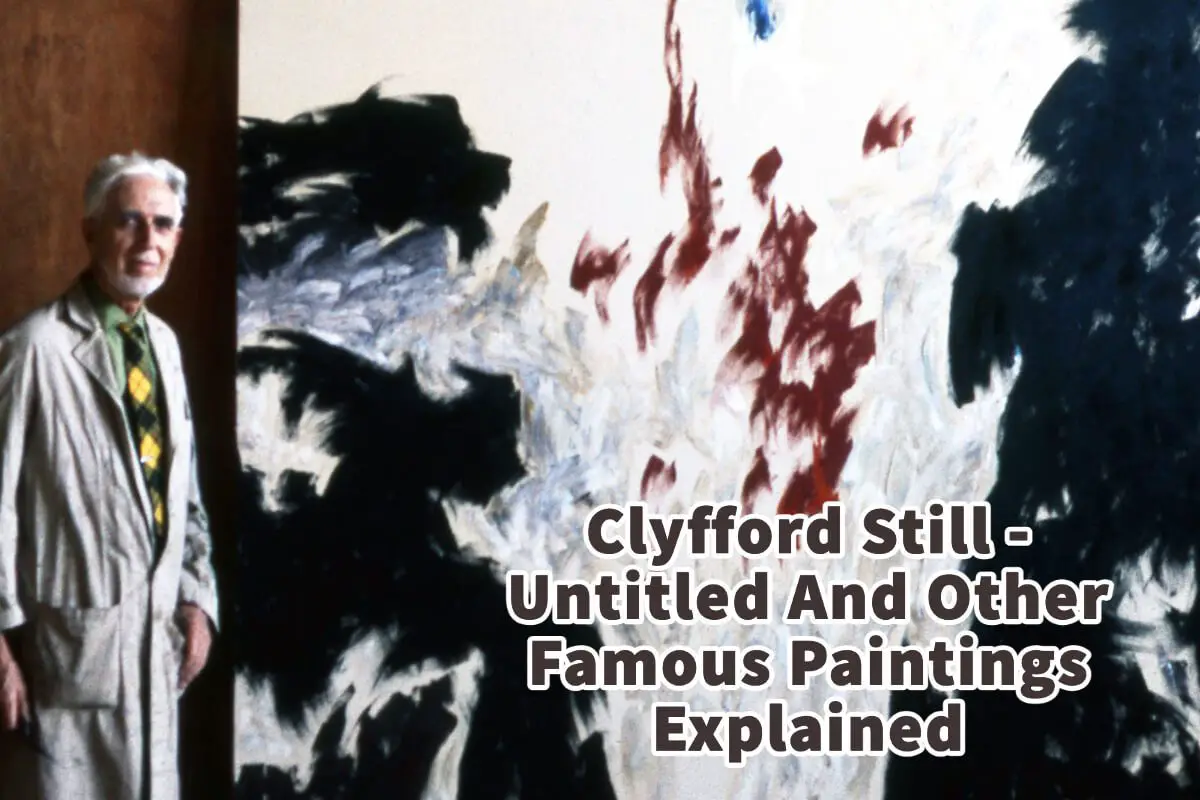Clyfford Still was one of the first Abstract Expressionism artists. He is one of the most influential American artists of the 20th century.
Clyfford Still has some works of art that continue to be famous or well known. Most of his artwork is shown at the Clifford Still Museum in Denver, Colorado, but some other popular pieces are scattered in museums and private collectors around the United States. Here are some of his well-known works of art.
Table of Contents
- Clyfford Still – Untitled 1959
- Clyfford Still- Untitled 1960
- Clyfford Still – PH-920, 1974 Or Untitled 1974
- Clyfford Still – 1957-D, No. 1
- Clyfford Still – 1948-C
- Frequently Asked Questions
- Related Questions
Clyfford Still – Untitled 1959

Clyfford Still, Untitled 1959 is a painting sold at auction in 2005. It was a cream, orange, and yellow painting sold by the Marlborough Gerson Gallery in New York City; the gallery said they acquired the painting directly from Stills.
The painting is 114 x 166 inches (289.5 x 421.6 cm). It was painted as the title implies in 1959.
What is unique about this is that so few Clyfford Still paintings are ever sold at auction. When Clyfford Still died in his will, he said he wanted his art to go to a place that would display and not sell it.
For over 20 years, most of his work was hidden from public view and left at his studio. In 2005 his widow Patti Still agreed to allow the City of Denver to build a Clyfford Still Museu. Today the Clyfford Still Museum is where most of his artwork is housed and shown.
That is why a painting like Untitled 1959 to even be up for auction is very rare; most of Clyfford Still’s artwork is forbidden from being sold.
Clyfford Still- Untitled 1960

Clyfford Still’s Untitled 1960 is on view at the Metropolitan Museum of Art in New York City. You can view this original painting at Gallery 921.
The painting is 113” x 146” (287 x 371.5 cm). It was given to the museum by his wife, Patti Stills, in 1986 after the artist had passed away.
Like many of Clyfford Still’s other paintings, this painting involves scenes of mountains or jagged rocks. The painting has some bright yet muted colors, with black being one of the predominant colors.
In speaking of the color black, Clyfford Still said:
“Black was never a color of death or terror for me. I think of it as warm – and generative.”
Clyfford Still
Clyfford Still – PH-920, 1974 Or Untitled 1974

PH-920, 1974 is sometimes also wrongly called Untitled 1974. The painting is located at the San Francisco Museum of Modern Art.
The painting is 114 1/4” x 170 1/2” or 290.2 x 433.07 cm. The painting was painted in 1974 but given to the museum by Clyfford Still in 1975.
It is an excellent example of how Still could use many of the darker colors, such as blacks and purples, with some bright splashes of color coming through.
In speaking of his paintings and the progression of his art, Clyfford Still said this:
“By 1941, space and figure in my canvases had been resolved into a total psychic entity, freeing me from the limitations of each, yet fusing into an instrument bounded only by the limits of energy and intuition. My feeling of freedom was now absolute and infinitely exhilarating.”
Clyfford Still
Clyfford Still – 1957-D, No. 1

(Photo Credit To City and Country of Denver / Artists Rights Society, New York found at Buffalo Akg Art Museum)
Another famous painting of Clyfford Still is 1957-D, No. 1. It is one of the paintings at the Albright Art Gallery.
The Albright Know Gallery (now known as the Buffalo AKG Art Museum) understood what a great and rare artist Clyfford Still was, but they also knew that for him, it was not about selling art as much as it was about other factors, such as how the art was displayed and viewed.

Listen To Our Podcast About The Life And Art Of Clyfford Still by clicking here.
Clyfford Still was known not to like art critics. He did not like his work to be interpreted. He was known to say that most art critics, art historians, and even museum curators did not fully understand his work.
That is why Clyfford Still would not sell many of his paintings or refused to sell them. Seymour H, Knox Jr, a patron of the Albright Knox Art Gallery, worked hard to get Still’s approval to purchase some paintings.
Still allowed Knox to purchase two paintings in 1959. The 1957-D No.1 was one of those paintings.
He also was known not to like his paintings to be separated from each other at exhibitions or even be exhibited with the work of other artists. He wanted his works of art to be viewed together and appreciated together.
Clyfford Still was known to say:
“Each painting is an episode in a personal history, an entry in a journal,” and “My work in its entirety is like a symphony in which each painting has its part.”
Clyfford Still
Clyfford Still was known to label his paintings with dates, letters, and numbers that gave them an order – almost like an artistic symphony all working together.
Still was pleased with the Albert Knox Art Gallery (now the Buffalo AKG Art Museum) and the reception and display of his paintings that in 1964, he donated to the gallery 31 more paintings.
Clyfford Still – 1948-C

Another famous Clyfford Still painting is the 1948-C, located at the Hirshhorn Museum and Sculpture Garden at the Smithsonian.
This painting is a very early Abstract Expressionism and shows how he developed his unique painting style early on.
The painting is 80 7/8” x 68 3/4 ” (205.4 x 174.6 cm). It was painted in 1948.
This painting was also put on a US postage stamp in 2010 for their Abstract Expressionism stamp series. Because it was placed on a US postage stamp series, many people have seen this painting but may not know it is a Clyfford Stills painting.
I love the work of Clyfford Stills. He was one of those unique independent artists who cared about the artwork and creative process more than money, fame, or anything else. If you want to see many Clyfford Stills artwork in one place, the Clyfford Still Museum in Denver, Colorado, is the best place to do it.
Anita Louise Art is dedicated to art education, great artists, and inspiring others to find and create their art. We love art that uplifts and inspires. #ArtToMakeYouSmile! #ArtToMakeYouHappy!
If you are interested to see any of my art, you can find out more by clicking here. If you are interested in what inspires me and my paintings, you can discover more by clicking here.
We have a free newsletter and would love you to be part of our community; you can subscribe to the newsletter by clicking here. I would be happy to talk to you if you have any questions. You can reach me, Anita, by clicking here.
Subscribe to our Anita Louise Art YouTube Channel with great videos and information by clicking here.
Join us for our podcast “5 Minutes With Art.” Spend just 5 minutes a week with us to discover and learn about great art and artists. You can find out more about our podcast by clicking here.
Frequently Asked Questions
What is Clyfford Still best known for in the art world?
Clyfford Still is renowned as one of the pioneers of Abstract Expressionism, a post-World War II art movement. He is celebrated for his unique approach to abstraction and his significant influence on American art.
Where can I view Clyfford Still’s most famous paintings?
The majority of Clyfford Still’s works are housed in the Clyfford Still Museum located in Denver, Colorado. However, some of his famous pieces are also found in various museums and private collections across the United States.
What makes Clyfford Still’s artwork distinctive within Abstract Expressionism?
Clyfford Still’s art is characterized by large, jagged forms, and intense colors. His use of bold, sweeping brushstrokes and a preference for monumental canvases set him apart within the Abstract Expressionist movement.
Can you name some of Clyfford Still’s most iconic paintings?
Some of Clyfford Still’s renowned paintings include “1957-J No. 2,” “1949-A-No. 1,” and “1950-L No. 2.” These artworks showcase his powerful, abstract style.
Why did Clyfford Still choose not to sell or exhibit the majority of his works during his lifetime?
Clyfford Still was known for his reclusive nature and strong desire to maintain control over his artistic legacy. He chose not to sell or exhibit the majority of his works to ensure they were not dispersed and remained intact.
What role does the Clyfford Still Museum play in preserving the artist’s legacy?
The Clyfford Still Museum serves as a dedicated institution to the artist, showcasing a substantial collection of his works. It plays a crucial role in preserving and presenting Still’s legacy to the public.
How did Clyfford Still’s early experiences influence his artistic style?
Still’s experiences growing up in the American West and working as a farmer contributed to his appreciation for vast landscapes, which is reflected in the scale and expansiveness of his paintings.
What is the significance of the untitled nature of many of Clyfford Still’s paintings?
Clyfford Still often chose to leave his paintings untitled to allow viewers to form their own interpretations. This lack of titles emphasizes the personal and emotional connection he intended for viewers to have with his work.
How did Clyfford Still’s work impact the development of American art in the 20th century?
Clyfford Still’s contributions to Abstract Expressionism had a profound impact on the evolution of American art. His emphasis on emotional expression and abstraction influenced subsequent generations of artists.
Are there any efforts to make Clyfford Still’s artwork more accessible to the public?
Yes, the Clyfford Still Museum actively engages in educational programs, exhibitions, and collaborations to make the artist’s work more accessible to the public. Efforts are made to share Still’s artistic vision and contributions with a wider audience.
Related Questions
What Was The American Gothic Painting by Grant Wood (1930)?
Grant Wood, the artist, was from Iowa. His painting American Gothic has a Carpenter Gothic Style house with a stoic man with a pitchfork and women staring off to the side outside the house. The painting received a 3rd place finish in an art competition at the Art Institute of Chicago. The painting has a lot of ambiguity, which leads to speculation about its true meaning. But all this ambiguity has raised its profile over the years.
You can read more by reading our blog, 17 Facts About the American Gothic Painting by Grant Wood (1930) by clicking here.
Who Was Georgia O’Keeffe, The Mother of American Modernism Painting?
Georgia O’Keeffe was a dairy farm girl from Wisconsin who became one of America’s great iconic painters. She received some college education but had to leave college due to her father’s untimely bankruptcy. When she was in school in New York, she met her future husband, the photographer and gallery owner Alfred Stieglitz. She is best known for her many American western subject matters and oversized flowers that she painted. She had a home and studio in the US state of New Mexico. You can visit her home in New Mexico and the Georgia O’Keeffe Museum in Santa Fe, New Mexico.
You can find out more by reading our blog Georgia O’Keeffe, The Mother of American Modernism Painting by clicking here.
Who Is the American Artist Norman Rockwell (1894-1973)?
Norman Rockwell is one of the most iconic American artists. His popular illustrations about daily life in America were on the front cover of the Saturday Evening Post magazine for over 47 years. Rockwell received success early and life. His artwork was in all the popular publications of his day. Today you can see many of his works of art at the Norman Rockwell Museum in Stockbridge, Massachusetts.
You can learn more by reading Who Is the American Artist Norman Rockwell (1894-1973)? by clicking here.


